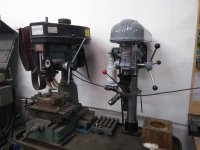Hi All,
I have an old Delta-Milwaukee drill press I rebuilt still has the original 3 phase motor, 3/4hp 1750 RPM, the drill press run well and has a cool turret attachment on it. But it goes a little fast for my application, even in the lowest drive ratio.
In the lowest ratio its 4.5:1 so 388 RPM'ish That's a little fast for a larger bit in the materials I use so I'm going to swap the motor.
I found 3 phase 1200 rpm motors 'reasonably' priced and that get's me down to 260'ish, I was considering over-sizing the motor a little and use a VFD to get me down lower when necessary, but I don't know the VFD de-rating rules so I can properly oversize.
Any Info would be nice.
Attached is it and it's glorified drill press friend, that has really good torque, don't need that much, but a little more than what I currently have.
Thanks

I have an old Delta-Milwaukee drill press I rebuilt still has the original 3 phase motor, 3/4hp 1750 RPM, the drill press run well and has a cool turret attachment on it. But it goes a little fast for my application, even in the lowest drive ratio.
In the lowest ratio its 4.5:1 so 388 RPM'ish That's a little fast for a larger bit in the materials I use so I'm going to swap the motor.
I found 3 phase 1200 rpm motors 'reasonably' priced and that get's me down to 260'ish, I was considering over-sizing the motor a little and use a VFD to get me down lower when necessary, but I don't know the VFD de-rating rules so I can properly oversize.
Any Info would be nice.
Attached is it and it's glorified drill press friend, that has really good torque, don't need that much, but a little more than what I currently have.
Thanks


